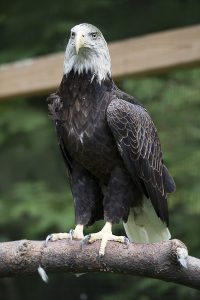An American Bald Eagle once treated at the Wildlife Hospital has joined Ohio Wildlife Center as a new Animal Ambassador.
Named Burton, to honor the late Dr. Don Burton who founded Ohio Wildlife Center, the Bald Eagle now occupies a new permanent raptor exhibit at Cook Road built through funds donated by the Barbara and Bill Bonner Family Foundation and the Swiatek family.
Burton was brought to the hospital in 2014 from Ross County and treated for wing injuries that did not heal sufficiently to allow him to be released back to the wild. He was housed at the Columbus Zoo and Aquarium for several years. After Ohio Wildlife Center staff completed extensive training and funding was obtained to build a Bald Eagle Enclosure that met federal habitat and size requirements for eagles, Burton returned to the Center.
As the national emblem and symbol of a true success story in conservation, the Bald Eagle is a compelling addition to the Center for its powerful narrative of human intervention to save a nearly extinct species, according to Education Director Stormy Gibson.
From a peak of nearly 100,000 Bald Eagles in 1782 to the 1963 census of only 487 nesting pairs in the U.S., it is now estimated there are 9,789 nesting pairs in the contiguous United States. The dynamics that nearly eradicated the raptors – loss of habitat, being shot and hunted, the use of DDT pesticide that affected egg and chick production — were addressed through aggressive federal legislation through the 1966 Endangered Species Act.
Gibson noted that in Ohio the rebound of the Bald Eagle has brought new challenges.
“With the growth and development in Central Ohio, the amount of suitable habitat has decreased, leading to more injuries as the birds compete for space or move into residential areas where they encounter more cars and buildings,” she said.
In 2014, 2015, and 2016, Ohio Wildlife Center’s Wildlife Hospital treated six Bald Eagles that were not able to be released due to the nature of their injuries. Placement sites in Ohio for permanently injured Bald Eagles are now exhausted, Gibson said, due to the special enclosures required to provide suitable habitats for these remarkable raptors.
In 2018, the Wildlife Hospital has already assessed and treated four Bald Eagles brought from Hocking, Morgan, Franklin and Licking Counties. One juvenile eagle diagnosed with West Nile Virus this spring required months of care and rehabilitation at the Pre-Release Facility.
“The arrival of Burton has been an amazing opportunity to offer the public a chance to see and learn about one of our nation’s treasures,” Gibson noted. “The story of the eagle and its recovery from near extinction is a powerful example of how human actions can reverse a potential tragedy in nature,” she said.
The new exhibit can accommodate up to three non-flighted Bald Eagles that are not release candidates. The exhibit can be viewed by the public during Second Sunday open houses at the Center.


